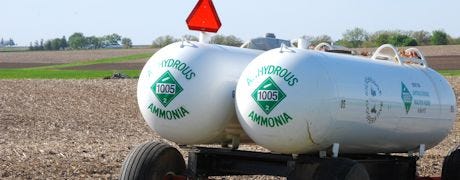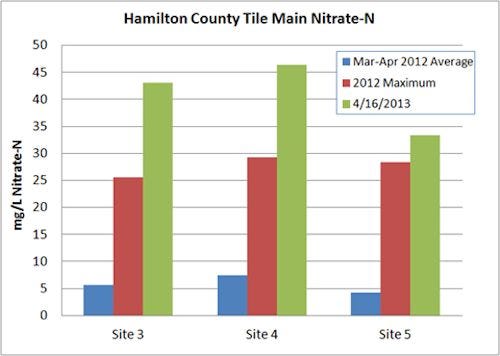
If you're like most Iowa row crop farmers, you've probably looked out the machine shed door and noticed that it's raining. That's only part of the story today. The rest is what this means with regard to soil nitrates, which you're probably counting on for your corn crop this year (when you can finally get into the fields to plant it).

COUNT ON CARRYOVER NITROGEN? For most of this spring, the focus was on how dry the subsoil was as a result of last year's drought. Now with heavy rains this past week and fieldwork put on hold, a different set of questions arises. For example, with this excessive rain what's happening to the carryover nitrate-N in the soil, leftover from 2012? Will it be there for the corn crop you are getting ready to plant? Can you count on carryover N?
With heavy rains soaking Iowa this past week or two, farmers are wondering how much of the nitrate-nitrogen that carried over from last year's drought-reduced crop will still be in the fields for this year's corn to use. Mick Lane, communications director for the Iowa Soybean Association's On-Farm Network, with the help of the network's staff, pulled together the following information to help answer that question and other questions farmers have about nitrogen this spring -- now that the weather has suddenly shifted from too dry to "it's getting way too wet."
In a number of fields, there is a lot of nitrogen that hasn't been applied yet, due to the wet weather keeping applicators out of fields so far this spring.
Are heavy rains in April washing away the carryover N from last year?
The Iowa Soybean Association Environmental Programs and Services group routinely monitors water flowing from three tile lines that empty into a creek that flows into the Upper Boone River. Along with the increased water flow that's come with the rain, the nitrate content of the water in two of these lines has jumped from 25 to 30 mg/L (parts per million) in March to more than 40 ppm earlier this week, as shown in the accompanying graph titled "Hamilton County Tile Main Nitrate-N."

What this suggests is a lot of nitrates are being flushed out of the soil and into flowing water. Odds are this is happening in most of Iowa, not just in the Boone River Watershed. It doesn't matter whether the nitrate was left in the soil after last year's drought-reduced corn crop, or if it is from mineralization of soil organic matter, or if it is coming out of what you've applied for the 2013 corn crop. What matters is it won't be there for the crop you're about to plant.
Post-Drought Soil And Fertility Issues
Just what has the drought left behind for the 2013 crop? And what steps do you need to take to get land ready for planting? Download our FREE report, 5 Post-Drought Strategies For A Better 2013.
~~~PAGE_BREAK_HERE~~~

The On-Farm Network tests cornstalks for nitrate content before harvest each fall in a number of locations in Iowa. This end-of-season cornstalk nitrate test gives you an idea as to how much carryover nitrogen might be in the soil for the next year's crop. In 2012, a drought year that reduced yields considerably, you would expect more N to carryover in the soil for the 2013 crop since the low-yielding 2012 crop didn't use as much N as it otherwise would if yields were higher.
Last year's On-Farm Network end-of-season stalk nitrate testing program showed considerably higher stalk nitrate levels than in the previous six years, with 45% of the samples collected in the "excessive" range. See the second graph accompanying this article.
A reasonable guess is that drought-stricken corn plants were able to take up more nitrogen than they were able to put into grain production. A portion of the nitrate from last year's higher-nitrate stalks, now on the soil surface or mixed into soil by tillage, will be mineralized by soil microbes and available to crops this year. How much of this N will be available and when depends on a host of factors, including soil temperature and moisture.
This situation brings up some very important nitrogen management questions
1) What's the status of nitrogen currently in the soil? Is there residual N left over from last year's crop? How much of the fertilizer nitrogen applied last fall or earlier this spring will still be there when the 2013 corn crop is finally ready to use it?
2) Is there anything a farmer can do to assure that his/her 2013 corn crop has adequate N?
A late spring (pre-sidedress) soil nitrate test can help you answer these questions. If all, or the majority, of your N fertilizer was applied before planting, the soil nitrate level from the late spring soil nitrate test can provide a guide for determining whether additional nitrogen fertilizer may be necessary to avoid a shortage for the corn plants later this summer.
Post-Drought Soil And Fertility Issues
Just what has the drought left behind for the 2013 crop? And what steps do you need to take to get land ready for planting? Download our FREE report, 5 Post-Drought Strategies For A Better 2013.
~~~PAGE_BREAK_HERE~~~
A description of the test and what it can (and cannot) do can be found on Page A3 of the 2006 On-Farm Network Conference proceedings. More on nitrogen management in a wet spring can be found in this 2007 On-Farm Network publication.
If you'd like to evaluate the adequacy of nitrogen you've applied or are planning to apply, there's still time to participate in the On-Farm Network's "Normal N rate +/- 50 pounds" strip trial or our "Manure +50" replicated strip trial project for 2013.
Benefits of participating in On-Farm Network nitrogen/manure trials
• Aerial imagery of trial fields is provided
• End-of-season stalk nitrate testing to compare nitrogen treatments
• Analysis of the overall trial, including a summary of yield differences between treatments
• Payment (in some cases) for yield loss due to reduced N rates
Check out the protocols for these trials - and all On-Farm Network trials. If you'd like more information on this, email Tristan Mueller, [email protected]or Anthony Martin [email protected] "Also, while we're plugging our 2013 replicated strip trial program, we still have opportunities for farmers to participate in these projects for 2031," says Lane. "
"Again, contact Tristan or Anthony for more information or to get signed up."
• Monsanto High Intensity
• Novozymes TagTeam LCO (seed treatment)
• Dupont-Pioneer Pre-emergence Herbicide
• World Soil Solutions Quantum (biological soil amendment) corn or soybeans
Post-Drought Soil And Fertility Issues
Just what has the drought left behind for the 2013 crop? And what steps do you need to take to get land ready for planting? Download our FREE report, 5 Post-Drought Strategies For A Better 2013.
About the Author(s)
You May Also Like




